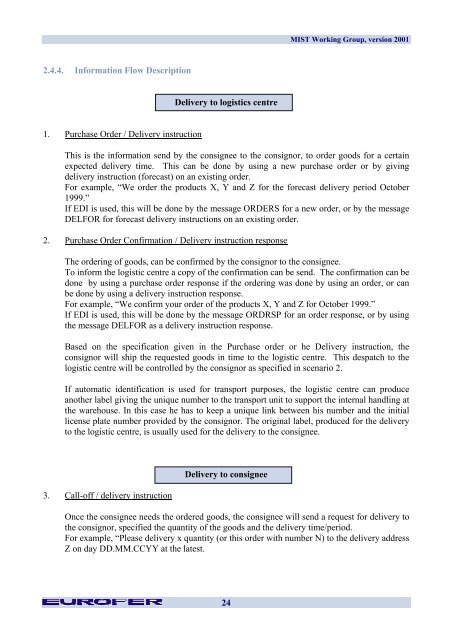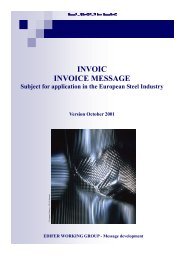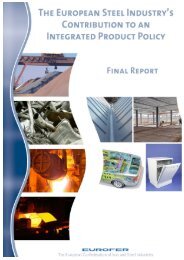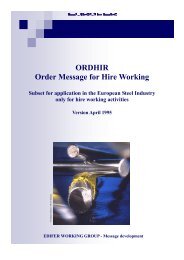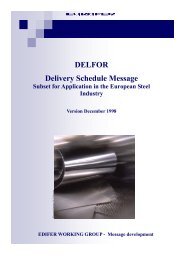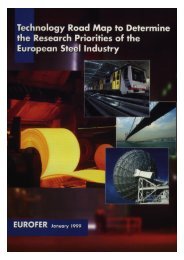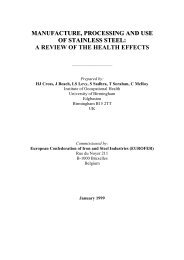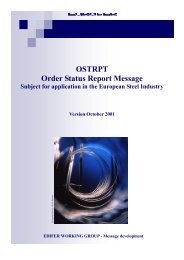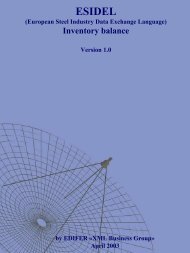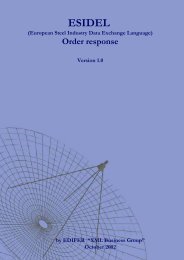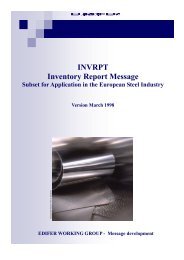Multi Industry Scenarios for Transport - Eurofer
Multi Industry Scenarios for Transport - Eurofer
Multi Industry Scenarios for Transport - Eurofer
Create successful ePaper yourself
Turn your PDF publications into a flip-book with our unique Google optimized e-Paper software.
2.4.4. In<strong>for</strong>mation Flow Description<br />
1. Purchase Order / Delivery instruction<br />
Delivery to logistics centre<br />
24<br />
MIST Working Group, version 2001<br />
This is the in<strong>for</strong>mation send by the consignee to the consignor, to order goods <strong>for</strong> a certain<br />
expected delivery time. This can be done by using a new purchase order or by giving<br />
delivery instruction (<strong>for</strong>ecast) on an existing order.<br />
For example, “We order the products X, Y and Z <strong>for</strong> the <strong>for</strong>ecast delivery period October<br />
1999.”<br />
If EDI is used, this will be done by the message ORDERS <strong>for</strong> a new order, or by the message<br />
DELFOR <strong>for</strong> <strong>for</strong>ecast delivery instructions on an existing order.<br />
2. Purchase Order Confirmation / Delivery instruction response<br />
The ordering of goods, can be confirmed by the consignor to the consignee.<br />
To in<strong>for</strong>m the logistic centre a copy of the confirmation can be send. The confirmation can be<br />
done by using a purchase order response if the ordering was done by using an order, or can<br />
be done by using a delivery instruction response.<br />
For example, “We confirm your order of the products X, Y and Z <strong>for</strong> October 1999.”<br />
If EDI is used, this will be done by the message ORDRSP <strong>for</strong> an order response, or by using<br />
the message DELFOR as a delivery instruction response.<br />
Based on the specification given in the Purchase order or he Delivery instruction, the<br />
consignor will ship the requested goods in time to the logistic centre. This despatch to the<br />
logistic centre will be controlled by the consignor as specified in scenario 2.<br />
If automatic identification is used <strong>for</strong> transport purposes, the logistic centre can produce<br />
another label giving the unique number to the transport unit to support the internal handling at<br />
the warehouse. In this case he has to keep a unique link between his number and the initial<br />
license plate number provided by the consignor. The original label, produced <strong>for</strong> the delivery<br />
to the logistic centre, is usually used <strong>for</strong> the delivery to the consignee.<br />
3. Call-off / delivery instruction<br />
Delivery to consignee<br />
Once the consignee needs the ordered goods, the consignee will send a request <strong>for</strong> delivery to<br />
the consignor, specified the quantity of the goods and the delivery time/period.<br />
For example, “Please delivery x quantity (or this order with number N) to the delivery address<br />
Z on day DD.MM.CCYY at the latest.


